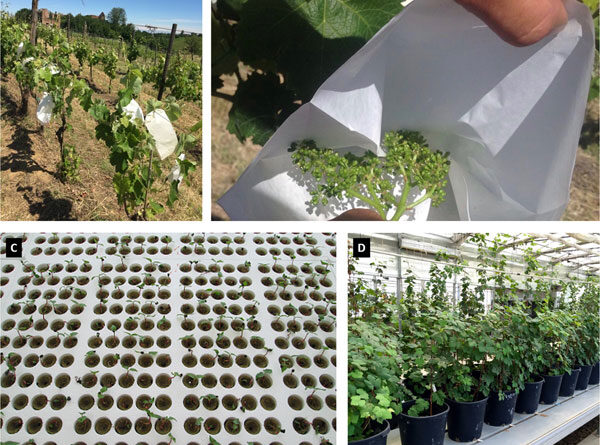The first loci of resistance to downy mildew in grapevine now available (Rpv29, Rpv30, Rpv31)
Up to a couple of years ago, the cultivated vine was considered susceptible to downy mildew. Recently, this belief has been disconfirmed. In fact, researchers of University of Milan discovered some resistant varieties to downy mildew in the germplasm of Caucasus (Georgia). One of these varieties is Mgaloblishvili. A more in-depth study uncovered three loci associated with the resistance (Rpv29, Rpv30, Rpv31). These three loci are located near plant defense genes against biotic stresses, such as genes involved in pathogen recognition and signal transduction. These three loci and their associated genes will revolutionize future vine breeding programs.
In figure: Some stages of Mgaloblishvili self-pollination (A,B), seedling germination (C) and plant maintenance in greenhouse (D).
REFERENCE
Sargolzaei M, Maddalena G, Bitsadze N, Maghradze D, Bianco PA, Failla O, Toffolatti SL and De Lorenzis G (2020) Rpv29, Rpv30 and Rpv31: Three Novel Genomic Loci Associated With Resistance to Plasmopara viticola in Vitis vinifera. Front. Plant Sci. 11:562432.
NOTES
The APC was funded by Dipartimento di Scienze Agrarie ed Ambientali (DiSAA; University of Milan).
The research was supported by University of Milan, DiSAA, Research Support Plan 2018, Linea 2 A, Project “Dal phenotyping al genome editing: strategie per limitare i danni da peronospora e legno nero in vite (ResVite) ”, and European Union within the project titled “FREECLIMB – Fruit Crops Adaptation To Climate Change In The Mediterranean Basin” in the frame of the Programme Partnership For Research And Innovation In The Mediterranean Area (PRIMA; call 2018).

